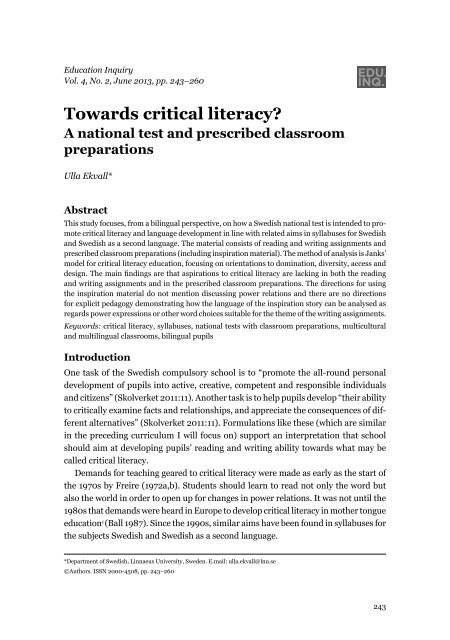Download issue - Umeå universitet
Download issue - Umeå universitet
Download issue - Umeå universitet
Create successful ePaper yourself
Turn your PDF publications into a flip-book with our unique Google optimized e-Paper software.
Education Inquiry<br />
Vol. 4, No. 2, June 2013, pp. 243–260<br />
EDU.<br />
INQ.<br />
Towards critical literacy?<br />
A national test and prescribed classroom<br />
preparations<br />
Ulla Ekvall*<br />
Abstract<br />
This study focuses, from a bilingual perspective, on how a Swedish national test is intended to promote<br />
critical literacy and language development in line with related aims in syllabuses for Swedish<br />
and Swedish as a second language. The material consists of reading and writing assignments and<br />
prescribed classroom preparations (including inspiration material). The method of analysis is Janks’<br />
model for critical literacy education, focusing on orientations to domination, diversity, access and<br />
design. The main findings are that aspirations to critical literacy are lacking in both the reading<br />
and writing assignments and in the prescribed classroom preparations. The directions for using<br />
the inspiration material do not mention discussing power relations and there are no directions<br />
for explicit pedagogy demonstrating how the language of the inspiration story can be analysed as<br />
regards power expressions or other word choices suitable for the theme of the writing assignments.<br />
Keywords: critical literacy, syllabuses, national tests with classroom preparations, multicultural<br />
and multilingual classrooms, bilingual pupils<br />
Introduction<br />
One task of the Swedish compulsory school is to “promote the all-round personal<br />
development of pupils into active, creative, competent and responsible individuals<br />
and citizens” (Skolverket 2011:11). Another task is to help pupils develop “their ability<br />
to critically examine facts and relationships, and appreciate the consequences of different<br />
alternatives” (Skolverket 2011:11). Formulations like these (which are similar<br />
in the preceding curriculum I will focus on) support an interpretation that school<br />
should aim at developing pupils’ reading and writing ability towards what may be<br />
called critical literacy.<br />
Demands for teaching geared to critical literacy were made as early as the start of<br />
the 1970s by Freire (1972a,b). Students should learn to read not only the word but<br />
also the world in order to open up for changes in power relations. It was not until the<br />
1980s that demands were heard in Europe to develop critical literacy in mother tongue<br />
education 1 (Ball 1987). Since the 1990s, similar aims have been found in syllabuses for<br />
the subjects Swedish and Swedish as a second language.<br />
*Department of Swedish, Linnaeus University, Sweden. E.mail: ulla.ekvall@lnu.se<br />
©Authors. ISSN 2000-4508, pp. 243–260<br />
243

















